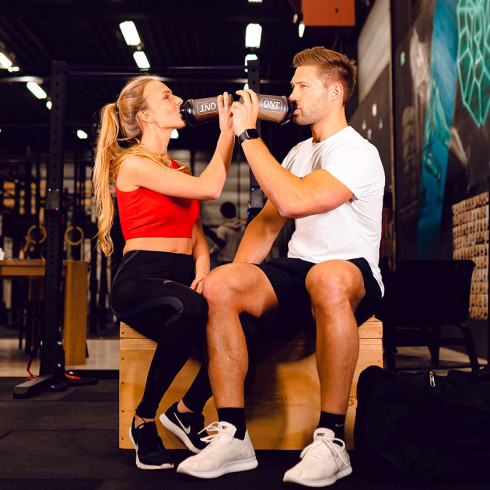Pre-Workout: What Is It For and How to Choose the Right One?
TABLE OF CONTENTS
- What is a pre-workout and what is it used for?
- What are the common ingredients in pre-workouts?
- When and how should I take my pre-workout?
- Can I take a pre-workout if I train in the evening?
- Should I take a pre-workout on rest days?
- What are the potential side effects of pre-workouts?
- Are pre-workouts safe and legal?
- Do pre-workouts help with weight loss?
- Can I combine multiple pre-workouts or mix them with other supplements?
- Are pre-workouts suitable for all types of sports?
- Coach’s tips
WHAT IS A PRE-WORKOUT AND WHAT IS IT USED FOR?
A PRE WORKOUT is a blend of ingredients that can help athletes looking to enhance their performance take it to the next level. When your training is already tailored to your goals and your nutrition is on point, there are still other ways to boost your progress. Pre-workouts are a great option because they help increase endurance, stamina, focus, and strength.
WHAT MAKES A GOOD PRE WORKOUT
- Energy boost: Many pre-workouts contain caffeine, which is well known for enhancing alertness, giving an energy boost, and helping every athlete feel a surge of energy not just at the start of their session, but throughout the workout.
- Improved endurance: Depending on their ingredients, pre-workouts can also benefit endurance athletes. Ingredients like beta-alanine help delay the build-up of lactic acid, allowing for prolonged intense efforts.
- A boost in strength and power: Many pre-workouts include creatine, which enhances the production of ATP (Adenosine Triphosphate)—the primary energy source for muscles during short, high-intensity efforts. Since ATP reserves are quickly depleted, creatine helps extend intense short bursts of performance.
- Enhanced muscle pump: Citrulline and arginine promote the production of NO (nitric oxide). During training, this results in a noticeable pump and swelling of the muscles, giving each session a unique feel thanks to the vasodilation these ingredients trigger. This process improves oxygen and nutrient delivery to the muscles, enhancing the pump and recovery.
- Improved focus and motivation: Certain compounds called nootropics—natural or synthetic—enhance mental functions such as memory, focus, motivation, and stress management. They’re often used to optimize mental performance. Many pre-workouts contain tyrosine, which is one of these compounds.
WHO SHOULD TAKE A PRE-WORKOUT?
In general, pre-workouts are for athletes looking to boost their performance, whether in bodybuilding, endurance sports, or other high-intensity activities. They can also be helpful for those needing a little push during temporary fatigue or after a particularly exhausting day at work.
Obviously, it's important to choose your pre-workout based on your goal, as well as your personality and sensitivities. If you're sensitive to caffeine, you need to know whether or not you can use it.
We can therefore say that a pre-workout can truly help an athlete reach their goals faster, but it’s essential to adapt your pre-workout to your specific goals and personal sensitivities.
WHAT ARE THE COMMON INGREDIENTS IN PRE-WORKOUTS?
As we’ve seen, there are many different types of pre-workouts, each containing different ingredients. Depending on the ingredients they contain, they are designed to improve physical or mental performance. Whether it’s to boost energy, delay fatigue, improve congestion, or enhance recovery, each ingredient serves its particular purpose.
CAFFEINE: MORE ENERGY AND FOCUS?
Most pre-workouts aim to give a boost, and caffeine is a very effective ingredient to stimulate the body. It reduces the sensation of fatigue and increases focus by acting on the nervous system, but it also stimulates adrenaline production, improving the use of energy reserves during exercise.
A dose of 150 to 300 mg per serving can help, depending on personal sensitivity.
BETA-ALANINE: INCREASED MUSCLE ENDURANCE
Beta-alanine is an amino acid that helps regulate intramuscular pH, delaying the effects of lactic acid. This leads to increased resistance to fatigue, especially during long-duration or high-intensity efforts.
When taking beta-alanine, you may experience some temporary tingling on the skin.
CREATINE: A STRENGTH SUPPLEMENT?
Creatine is often present in pre-workouts because it is a well-known supplement, and its effectiveness is well established. Its positive effects on strength, power, and recovery make it an essential asset in many pre-workouts.
However, some pre-workouts may not contain enough creatine to be effective. It’s also worth noting that some studies have questioned the addition of sugar or caffeine on the effectiveness of creatine. But the discussion on this topic is still open.
The effective dosage for creatine is between 6 to 8 g per day, to be taken before and after training or in 3 doses throughout the day when not training.
BCAAs: OPTIMAL RECOVERY AFTER WORKOUTS
Branched-chain essential amino acids, BCAAs, including leucine, isoleucine, and valine, play a crucial role in muscle recovery. They promote protein synthesis and limit muscle breakdown due to exercise.
A dose of 5 to 10 g before or during training is often ideal.
ARGININE: EFFECTIVE CONGESTION
Arginine, like citrulline, helps in the production of NO (nitric oxide), which increases vasodilation and better nutrient delivery to the cells. The visible result is an enhanced feeling of congestion during training.
An effective dose is between 3 to 6 g before a session.
NOOTROPICS: INCREASED FOCUS AND LESS STRESS
Some pre-workouts may contain nootropic substances such as tyrosine or Alpha-glycerylphosphorylcholine. These can help maintain optimal focus, reduce mental fatigue, and improve motivation.
An effective dose is between 500 mg and 1 g of L-tyrosine.
The ingredients in pre-workouts are blended to create a synergistic formula. Be sure to check the dosages of the elements that interest you. They will help boost your workouts and help you progress. It may be beneficial to vary your pre-workouts to avoid habituation and optimize your progress.
WHEN AND HOW SHOULD I CONSUME MY PRE-WORKOUT?
Of course, the ingredients that make up a pre-workout are the main elements of its effectiveness, but the timing and method of consumption also play an important role in achieving optimal effects.
A well-timed intake helps maximize its effects, whether it's an energy boost, improved endurance, or better muscle congestion.
WHEN TO TAKE YOUR PRE-WORKOUT?
To fully benefit from the active ingredients, it is recommended to consume your pre-workout about 20 to 30 minutes before the workout. This timing allows stimulants like caffeine to reach their peak concentration in the blood right when the effort begins.
Factors to consider:
- Caffeine sensitivity: If you're sensitive to stimulants, it might be a good idea to test a lower dose to avoid a sudden energy spike.
- Morning workouts: If you train on an empty stomach, it is better to opt for a pre-workout containing amino acids (BCAAs, citrulline) to avoid muscle breakdown.
- Late-night sessions: In the evening, choose a caffeine-free version to avoid sleep disturbances.
HOW TO CONSUME YOUR PRE-WORKOUT?
Pre-workouts come in various forms, each with its advantages:
- 1. Powder to mix with water: This is the most common form. It allows for rapid absorption and an adjustable dosage. Most brands recommend diluting one serving in 200 to 300 ml of water, but this can vary depending on the desired intensity.
- 2. Capsules or tablets: A practical alternative for those who want to avoid the sometimes intense taste of powders. However, the effect takes slightly longer to be felt due to the digestion time.
- 3. Pre-workout liquids (shots): These ready-to-use formats offer ultra-fast absorption and are convenient to carry.
Tips for optimal intake:
- Stay hydrated: Some ingredients like creatine or beta-alanine require proper hydration to avoid muscle cramps.
- Avoid taking on an empty stomach if you're sensitive to stimulants: A light snack (banana, handful of almonds) can help reduce potential stomach discomfort.
- Test your tolerance: Start with half a dose if you're new to pre-workouts, to assess your reaction to the stimulants.
A well-dosed pre-workout taken at the right time can significantly improve the quality of your workout. To avoid any undesirable effects, tailor your intake to your routine and sensitivity to the different ingredients. And most importantly, remember that a good workout relies primarily on a balanced diet and sufficient rest.
CAN I TAKE A PRE-WORKOUT IF I TRAIN IN THE EVENING?
Some may hesitate before taking a pre-workout in the evening. It's great to get a boost, but some ingredients can interfere with sleep. Certain ingredients, particularly stimulants like caffeine, can stay active in the body for several hours, potentially leading to difficulty falling asleep. Fortunately, there are alternatives suited for late-night sessions.
THE RISKS OF TAKING A PRE-WORKOUT IN THE EVENING
- Difficulty falling asleep: Caffeine can remain active up to 6 hours after ingestion, delaying sleep onset.
- Poor quality sleep: Even if you manage to fall asleep, stimulants can reduce deep sleep, leading to less effective muscle recovery.
- Risk of anxiety or restlessness: A high dose of caffeine late in the day can cause excessive nervousness, impairing post-workout relaxation.
SOLUTIONS FOR EVENING PRE-WORKOUTS
If you train late and still want a boost for your session, here are some more suitable alternatives:
- 1. Choose a stimulant-free pre-workout: There are pre-workout formulas without caffeine or other stimulants, focusing instead on ingredients that promote endurance and muscle congestion. These products generally contain:
- Citrulline and arginine: To improve blood flow and "pump".
- Beta-alanine: To delay muscle fatigue.
- BCAAs: To protect muscles and improve recovery.
- 2. Reduce the dose of a classic pre-workout: If you are using a pre-workout containing stimulants, try halving the dose to minimize the impact on sleep.
- 3. Avoid caffeine after 4 PM: If you are particularly sensitive to stimulants, it’s best to avoid any caffeine-containing products several hours before bed.
- 4. Opt for alternative supplements: Instead of using a classic pre-workout, you can choose other natural supplements before evening training:
- Magnesium: Helps with muscle relaxation and stress management.
- Theanine: An amino acid that promotes focus without the stimulating effect.
- Electrolytes: To ensure proper hydration and reduce fatigue.
Yes, it is possible to take a pre-workout before an evening workout, but it is essential to adjust the formula to your schedule. To avoid disrupting sleep, choose a caffeine-free version, reduce the dosage, or explore natural alternatives that promote endurance and recovery. Since good sleep is as crucial as the workout itself, it’s best to optimize your routine accordingly.
SHOULD I CONSUME A PRE-WORKOUT ON REST DAYS?
Pre-workouts are specifically designed to optimize physical performance by increasing energy, endurance, and focus during workout sessions. But what about the days when you're not training? Should you continue taking them, or is it unnecessary?
THE ROLE OF PRE-WORKOUT: A USE LINKED TO TRAINING
The primary goal of a pre-workout is to provide an immediate energy boost before a workout. It often contains stimulants like caffeine, which are not needed on rest days, except in certain specific cases.
In general, it is not recommended to take a pre-workout on rest days, as most of its effects are temporary and intended to enhance the current workout.
WHEN CAN A PRE-WORKOUT BE USEFUL ON REST DAYS?
There are, however, certain situations where taking some components of the pre-workout can be beneficial even without a workout:
- 1. MUSCLE RECOVERY (CREATINE, BCAA, ELECTROLYTES)
Creatine, often found in pre-workouts, works by accumulating in the body. It is therefore recommended to consume it daily, even on rest days, to optimize its effects on strength and recovery. BCAAs and electrolytes can be useful for promoting hydration and reducing muscle catabolism, especially if your rest is active (walking, stretching, active recovery). - 2. ENERGY AND FOCUS (CAFFEINE, NOOTROPICS)
If you use your pre-workout mainly for its stimulating effect, it can be taken on rest days to improve focus and alertness (for example, before a mentally demanding task). However, it's better to opt for a more natural source of caffeine, such as tea or coffee, to avoid becoming accustomed to the high doses found in pre-workouts. - 3. PREPARATION FOR A TRAINING CYCLE
If you are following a supplementation cycle (for example, with creatine or beta-alanine), certain molecules need to be consumed continuously to maximize their effects. In this case, it might be interesting to consume some of them separately, without needing to take the entire pre-workout.
ALTERNATIVES TO PRE-WORKOUT ON REST DAYS
If you feel the need for a nutritional boost or a light energy boost, here are some alternatives more suitable for rest days:
- Green tea or coffee: For a gentler stimulating effect than a pre-workout.
- Proteins and BCAAs: To support muscle recovery without excessive stimulation.
- Magnesium and electrolytes: For better recovery and reducing muscle cramps.
As a general rule, it is unnecessary to consume a pre-workout on days when you're not training, as its primary function is to enhance performance during exercise. However, some of its components, such as creatine or BCAAs, can be beneficial for recovery and can be taken independently of the pre-workout. To avoid becoming accustomed to stimulants, it is recommended to alternate with gentler alternatives on rest days.
WHAT ARE THE POTENTIAL SIDE EFFECTS OF PRE-WORKOUTS?
Pre-workouts are designed to enhance physical performance by increasing energy, endurance, and focus. However, their composition, often rich in stimulants and vasodilators, can lead to side effects in some individuals. Knowing these risks allows for safer consumption tailored to your profile.
THE MAIN SIDE EFFECTS OF PRE-WORKOUTS
- 1. PALPITATIONS AND INCREASED HEART RATE
Caffeine, which is abundant in pre-workouts, stimulates the central nervous system, which can accelerate the heart rate. A high dose can cause palpitations, nervousness, and in some cases, increased blood pressure.
Solution: Reduce the dose and avoid consuming other sources of caffeine throughout the day (coffee, tea, energy sodas). - 2. SLEEP DISTURBANCES
Caffeine and other stimulants can remain active in the body for several hours, delaying sleep onset or reducing the quality of deep sleep.
Solution: Avoid taking a pre-workout after 4 PM or opt for a stimulant-free version for late-night sessions. - 3. NAUSEA AND DIGESTIVE DISORDERS
Certain ingredients, such as beta-alanine, creatine, or artificial sweeteners, can cause stomach discomfort, bloating, or nausea.
Solution: Dilute the pre-workout in a larger amount of water and consume it gradually instead of drinking it all at once. - 4. TINGLING AND NUMBNESS (PARESTHESIA)
Beta-alanine, a commonly used ingredient for delaying muscle fatigue, can cause a tingling sensation on the skin, especially on the face and hands.
Solution: This phenomenon is harmless, but if the sensation is too uncomfortable, it may be best to reduce the dose. - 5. INCREASED BLOOD PRESSURE
The stimulants and vasodilators in pre-workouts can cause a temporary increase in blood pressure.
Solution: Individuals with hypertension or heart problems should consult a doctor before consuming pre-workouts. - 6. ANXIETY AND RESTLESSNESS
A high dose of caffeine can lead to psychological side effects, such as anxiety, irritability, or difficulty focusing on other tasks after the workout.
Solution: Start with half a dose to assess tolerance and choose formulas with less stimulants.
HOW TO AVOID THESE UNDESIRABLE EFFECTS?
- Start with a low dose: It is better to test with half a packet or half a scoop of pre-workout to observe your body's reaction.
- Check the composition: Choose products with transparent ingredients and avoid pre-workouts that contain a "proprietary blend" without precise dosages.
- Stay properly hydrated: Some components, like creatine, require proper water intake to avoid cramps or headaches.
- Space out stimulant consumption: Limit caffeine intake outside of the pre-workout to avoid stimulant overload.
Pre-workouts are effective allies for boosting performance during training, but they should be used with caution to avoid side effects. By respecting the dosages and choosing a formula suited to one's needs and sensitivity to stimulants, it is possible to enjoy their benefits while minimizing risks. For any concerns, it is recommended to consult a healthcare professional before incorporating a pre-workout into your routine.
ARE PRE-WORKOUTS SAFE AND LEGAL?
Before integrating a pre-workout into your routine, it is essential to ensure that it is safe for your health and complies with the current regulations in your country. The safety of a supplement depends on several factors: the quality of the ingredients, adherence to dosages, the absence of banned substances, and product traceability.
THE SAFETY OF PRE-WORKOUTS: WHAT YOU NEED TO KNOW
Most pre-workouts available on the market are formulated to be consumed safely, but certain points deserve particular attention:
- 1. INGREDIENT QUALITY AND TRANSPARENCY
A reliable product should display a clear and detailed list of ingredients, without "proprietary blends" that do not specify exact dosages.
Serious brands conduct laboratory tests to ensure the absence of contaminants or banned substances. - 2. ADHERENCE TO RECOMMENDED DOSAGES
Certain ingredients, such as caffeine or beta-alanine, should be consumed in moderate amounts to avoid side effects.
It is recommended to start with half a dose to assess tolerance, especially if you have never used a pre-workout before. - 3. PRODUCT ORIGIN AND CERTIFICATIONS
Opt for products made in GMP-certified facilities (Good Manufacturing Practices) or subject to strict quality controls.
Some labels such as ISO, HACCP, or Informed-Sport guarantee production in compliance with safety standards.
HOW TO ENSURE YOU CHOOSE A SAFE PRE-WORKOUT?
- Buy from recognized brands that adhere to manufacturing standards. Avoid formulas containing controversial stimulants and prefer those with scientifically validated ingredients.
- Check labels and certifications that guarantee quality and the absence of banned substances.
- Consult a healthcare professional if you have medical history concerns before taking any supplement.
THE LEGALITY OF PRE-WORKOUTS: WHAT IS ALLOWED AND WHAT IS NOT
Supplement regulations vary by country, and some ingredients that are allowed in one region may be banned in another.
Banned or regulated substances in certain countries:
- DMAA (1,3-dimethylamylamine): A powerful stimulant previously used in pre-workouts, but banned in many countries due to its cardiovascular effects.
- Yohimbine: Found in some fat burners and pre-workouts, this substance is regulated in Europe and banned in several countries.
- Synephrine: Allowed in some countries but subject to restrictions elsewhere due to its effects on blood pressure.
How to check the legality of a pre-workout?
- Check official lists from health authorities (EFSA in Europe, FDA in the U.S., ANSES in France).
- Verify if the product is sold in recognized specialized stores or only on unreliable websites.
- Avoid buying products containing unlisted exotic ingredients as they may be banned or dangerous.
Pre-workouts are generally safe when consumed correctly and sourced from brands that adhere to quality standards. However, it is crucial to check their composition and compliance with local regulations to avoid health risks and potential legal issues. By choosing a reliable product suited to your needs, you can fully enjoy the benefits of a pre-workout safely.
DO PRE-WORKOUTS HELP WITH WEIGHT LOSS?
Pre-workouts are primarily designed to improve physical performance, but some of their ingredients can also play a role in weight management. However, a pre-workout is not a miracle solution: it can accompany a weight loss program, but it does not replace a balanced diet or an active lifestyle.
HOW CAN A PRE-WORKOUT PROMOTE WEIGHT LOSS?
Some components of pre-workouts have an indirect effect on fat loss by increasing metabolism, caloric expenditure, and fat mobilization during exercise. Here are the main mechanisms at play:
- 1. STIMULATION OF METABOLISM (CAFFEINE AND THERMOGENESIS)
Caffeine, one of the most common ingredients, is known for its thermogenic effect: it increases heat production in the body, thus promoting higher energy expenditure.
It also stimulates the nervous system, which can reduce the feeling of fatigue and allow for longer and more intense workouts, thereby increasing calorie consumption. - 2. USE OF FAT AS AN ENERGY SOURCE
Caffeine and certain plant extracts (such as L-carnitine) promote the mobilization of fatty acids, making them more available to be used as an energy source during exercise.
This can be beneficial for those practicing fasted cardio or looking to improve fat oxidation. - 3. IMPROVED ENDURANCE AND TRAINING INTENSITY
Ingredients like beta-alanine or citrulline allow for longer efforts and optimized muscle performance, helping to burn more calories during a full session.
A longer and more intense workout means a higher energy expenditure, which can contribute to a calorie deficit conducive to weight loss. - 4. TEMPORARY APPETITE SUPPRESSION
Some pre-workouts containing caffeine or synephrine can cause a slight suppression of appetite in the short term, which can be an asset for those looking to limit their caloric intake.
THE LIMITATIONS OF PRE-WORKOUTS IN WEIGHT LOSS
- They don’t directly burn fat: A pre-workout doesn’t melt fat by itself; it only acts as a catalyst to increase performance and energy.
- Excessive consumption can be counterproductive: Too many stimulants can increase stress and cortisol, a hormone associated with fat storage, especially in the abdominal area.
- They don’t replace a balanced diet: To lose weight sustainably, it is essential to maintain a caloric deficit through a suitable diet and regular physical activity.
HOW TO USE A PRE-WORKOUT TO OPTIMIZE WEIGHT LOSS?
- Choose a suitable formula: Opt for a pre-workout containing ingredients beneficial for metabolism, such as caffeine, L-carnitine, or green tea extract.
- Pair it with an effective workout: Ideally, take it before intense sessions (HIIT, weightlifting, cardio) to maximize energy expenditure.
- Control calorie intake: Even though pre-workouts help burn more calories, an adapted diet remains essential for weight loss.
A pre-workout can be an ally in a weight loss program thanks to its effects on energy, endurance, and metabolism. However, it does not replace either a good diet or a structured workout. For optimal results, it should be used as a complement to an active and balanced lifestyle. It is also important to note that pre-workouts offer different calorie counts, which should be taken into account when aiming for weight loss and should also guide your choice of pre-workout.
CAN I COMBINE MULTIPLE PRE-WORKOUTS OR MIX THEM WITH OTHER SUPPLEMENTS?
Pre-workouts are formulated to provide a balanced mix of ingredients aimed at improving performance, endurance, and concentration. However, the temptation to combine multiple pre-workouts or mix them with other supplements may arise, especially to maximize the effects felt. Yet, this comes with potential risks that it is important to know before combining them.
CAN YOU MIX MULTIPLE PRE-WORKOUTS?
In general, it is not recommended to combine multiple pre-workouts, and for several reasons:
- 1. RISK OF OVERDOSING ON STIMULANTS (CAFFEINE, SYNEPHRINE, YOHIMBINE)
Caffeine, found in most pre-workouts, is a powerful stimulant that can cause palpitations, anxiety, and sleep disturbances if consumed in excess.
Some pre-workouts contain other stimulants like synephrine or yohimbine, which can amplify these side effects when combined.
Dosage not to exceed: The recommended daily dose of caffeine for an adult is around 400 mg. With multiple pre-workouts, this threshold can be quickly exceeded. - 2. INTERACTIONS BETWEEN INGREDIENTS
Some ingredients like beta-alanine, citrulline, or creatine are present in multiple pre-workouts. Combining them could result in excessive amounts that offer no additional benefit and may cause discomfort (paresthesia, bloating, digestive issues).
Formulas containing vasodilators (citrulline, arginine) should be consumed in moderation to avoid an excessive drop in blood pressure. - 3. DECREASED LONG-TERM EFFECTIVENESS
Excessive stimulants can lead to habituation, requiring higher doses to achieve the same effects. This can lead to dependency on pre-workouts and reduce their effectiveness over time.
CAN YOU COMBINE A PRE-WORKOUT WITH OTHER SUPPLEMENTS?
Some supplements can be integrated safely with a pre-workout, while others require precautions:
SUPPLEMENTS COMPATIBLE WITH A PRE-WORKOUT
- Creatine: Can be taken alongside a pre-workout if not already included in the formula. It enhances energy production and promotes muscle recovery.
- BCAAs (branched-chain amino acids): Help limit muscle breakdown and promote recovery, without interfering with the ingredients in the pre-workout.
- Electrolytes: Essential for hydration, especially during intense workouts.
- L-Carnitine: Promotes fat oxidation and can be a good complement for workouts focused on weight loss.
SUPPLEMENTS NOT RECOMMENDED WITH A PRE-WORKOUT
- Thermogenic fat burners: Most contain stimulants (caffeine, yohimbine, synephrine). Combining them with a pre-workout increases the risk of unwanted side effects.
- Other sources of caffeine: Energy drinks, coffee, or caffeinated sodas can exacerbate the side effects of pre-workouts.
- Vasodilator mixtures: Too much citrulline, arginine, or nitrates can lead to an excessive drop in blood pressure.
HOW TO PROPERLY DOSE A PRE-WORKOUT FOR SAFE CONSUMPTION?
- Carefully read the label: Check the amount of caffeine and other stimulants to avoid overdosing.
- Do not exceed one serving per day: A properly dosed pre-workout is sufficient to boost your workout.
- Space out stimulant sources: If you take other supplements containing caffeine, adjust the doses to stay below 400 mg per day.
- Consult a professional: If you're unsure about combining supplements, consult a doctor or a sports nutrition specialist.
It is not recommended to combine multiple pre-workouts, as this significantly increases the risk of overdosing on stimulants and side effects. However, some supplements like creatine, BCAAs, and electrolytes can be used in addition to a pre-workout safely. The key is to control the dosages, avoid excessive caffeine, and adapt the combinations according to your goals and tolerance to stimulants.
ARE PRE-WORKOUTS SUITED FOR ALL TYPES OF SPORTS?
Pre-workouts are often associated with strength and endurance sports, but their usefulness can vary depending on the discipline. Their composition, focused on improving physical and mental performance, may not be suitable for all types of training. It is essential to adjust their use according to the specific requirements of each sport.
SPORTS FOR WHICH PRE-WORKOUTS ARE MOST BENEFICIAL
Some sports particularly benefit from the effects of pre-workouts due to their ingredients that boost energy, endurance, and concentration.
- 1. BODYBUILDING AND WEIGHTLIFTING
Improved explosive strength with caffeine and creatine.
Delay of muscle fatigue with beta-alanine and BCAAs.
Increased muscle congestion with citrulline and arginine.
Recommended - 2. CROSSFIT AND HIGH-INTENSITY TRAINING (HIIT)
Provides a quick energy boost to support session intensity.
Better muscle recovery between rounds of effort.
Recommended - 3. ENDURANCE SPORTS (RUNNING, CYCLING, SWIMMING, TRIATHLON)
Optimization of fat usage as an energy source with L-carnitine.
Increased muscle oxygenation via citrulline and arginine.
Improvement in mental focus over long durations.
Recommended in moderation, favoring stimulant-free versions to avoid excessive heart rate acceleration.
SPORTS FOR WHICH PRE-WORKOUTS ARE LESS RELEVANT
Some sports do not require a pre-workout and may even be disrupted by the effects of some of its ingredients.
- 1. TECHNICAL SPORTS (GOLF, SHOOTING, DANCE, CHESS, ETC.)
Caffeine and other stimulants can harm precision and coordination.
An overload of energy can be counterproductive for disciplines requiring calmness and control.
Not recommended - 2. TEAM SPORTS (SOCCER, BASKETBALL, RUGBY, HANDBALL)
Improved concentration and explosiveness can be useful, but the presence of stimulants can cause excessive nervousness.
The thermogenic effects can also accelerate dehydration, a critical point in these sports.
To be used with caution, prefer low-caffeine versions. - 3. COMBAT SPORTS (BOXING, JUDO, MMA, KARATE, ETC.)
An excess of stimulants can lead to shaking or a loss of precision in technical movements.
Risk of heart rate acceleration that may hinder endurance management during a long fight.
To be avoided in competition, can be used in small doses during training.
HOW TO CHOOSE A PRE-WORKOUT SUITED TO YOUR SPORT?
- For strength and explosiveness sports: Choose pre-workouts rich in creatine, beta-alanine, and caffeine.
- For endurance sports: Opt for stimulant-free formulas with citrulline and electrolytes.
- For sports requiring precision: Avoid formulas with too many stimulants, which can impair coordination and fine concentration.
Pre-workouts are not universally suited to all sports. While they are particularly effective for strength and endurance disciplines, their stimulant effect can be a disadvantage in sports that require precision or optimal heart rate control. Before consuming them, it is essential to choose a formula tailored to your needs and to test your tolerance outside of competitions to avoid any negative surprises.
COACH'S TIPS

- Ideally, you should have several pre-workouts on hand to adapt them based on your sensitivity or schedule. One with caffeine for daytime workouts and one without for evening sessions. Also, be careful not to always take a caffeinated pre-workout before every training session, or you might get used to it and lose the desired effect.
- At QNT, we offer different pre-workouts: Without caffeine: Pump RX, or with caffeine: Elite NO, Kick pre-workout, Guarana Kick, Energel Quick, Thermo Booster, Guarana Extreme Voltage, Hydravol, Overdrive.
Related posts
-
 Summer holidays: How to limit the damage?
Posted in: Our tips24/06/2021On holiday, we often tend to let ourselves go. Unless you're a hardcore sportsman, you tend to abandon your trainers...Read more
Summer holidays: How to limit the damage?
Posted in: Our tips24/06/2021On holiday, we often tend to let ourselves go. Unless you're a hardcore sportsman, you tend to abandon your trainers...Read more -
 Which fat burner to choose?
Posted in: Our tips26/05/2021To lose weight and burn fat, there is no secret: you have to do sport and take care of your diet. However, it is...Read more
Which fat burner to choose?
Posted in: Our tips26/05/2021To lose weight and burn fat, there is no secret: you have to do sport and take care of your diet. However, it is...Read more -
 Summer body edition for men: How to prepare your body?
Posted in: Our tips11/05/2021Gentlemen ? The return of the sun and its warm rays are almost here! The degrees are slowly but surely rising, but...Read more
Summer body edition for men: How to prepare your body?
Posted in: Our tips11/05/2021Gentlemen ? The return of the sun and its warm rays are almost here! The degrees are slowly but surely rising, but...Read more -
 9 good reasons to do sport.
Posted in: Our tips22/04/2021Sometimes the urge to exercise is not always there. And although we always tell ourselves that this year will finally...Read more
9 good reasons to do sport.
Posted in: Our tips22/04/2021Sometimes the urge to exercise is not always there. And although we always tell ourselves that this year will finally...Read more -
 Discover how to take care of your faithful companion: your shaker!
Posted in: Our tips07/04/2021In your bag, in your hand, in your sink, it is everywhere! The shaker is an essential element of any good training....Read more
Discover how to take care of your faithful companion: your shaker!
Posted in: Our tips07/04/2021In your bag, in your hand, in your sink, it is everywhere! The shaker is an essential element of any good training....Read more
Blog categories
Popular posts
-
 Looking thinner but at a heavier weight? Is that possible?04/10/2021Posted in: Our tipsAdvertising has shaped our thinking! We have been forced for years to believe that losing weight is the key to having...Read more
Looking thinner but at a heavier weight? Is that possible?04/10/2021Posted in: Our tipsAdvertising has shaped our thinking! We have been forced for years to believe that losing weight is the key to having...Read more -
 Proteins for weight loss !29/12/2023Posted in: Our tipsDive into the fascinating world of proteins and their key role in weight loss. Discover how to choose the best...Read more
Proteins for weight loss !29/12/2023Posted in: Our tipsDive into the fascinating world of proteins and their key role in weight loss. Discover how to choose the best...Read more -
 10 BENEFITS OF GLUTAMINE.02/01/2024Posted in: Our tipsDiscover the power of L-glutamine, an underrated superhero in the world of amino acids! Essential for revitalizing...Read more
10 BENEFITS OF GLUTAMINE.02/01/2024Posted in: Our tipsDiscover the power of L-glutamine, an underrated superhero in the world of amino acids! Essential for revitalizing...Read more -
 Which foods boost testosterone levels ?07/05/2021Posted in: Food supplementsTestosterone, often associated with virility, has much more to offer than you might think. It plays a crucial role in...Read more
Which foods boost testosterone levels ?07/05/2021Posted in: Food supplementsTestosterone, often associated with virility, has much more to offer than you might think. It plays a crucial role in...Read more -
 Is there a link between sex and sport?14/11/2019Posted in: LifestyleMany have already asked questions about sex and sport. Most of the time, people want to be reassured by the many...Read more
Is there a link between sex and sport?14/11/2019Posted in: LifestyleMany have already asked questions about sex and sport. Most of the time, people want to be reassured by the many...Read more

.jpg)

